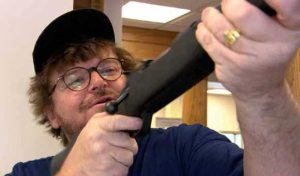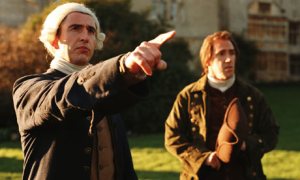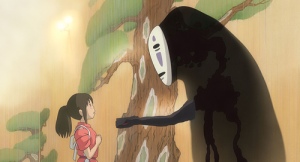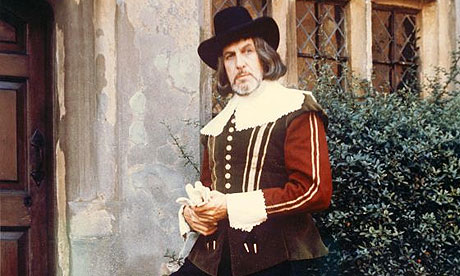The 100 Films Of The Decade: 30 – 21
30 Bowling For Columbine (2002)
In the decade’s best documentary feature, Michael Moore attempts to examine the complex problems of America’s culture of violence and gun ownership, centred around the 1999 Columbine high school shootings. The causes and solutions are many and complicated, but Bowling For Columbine definitely teaches us to be wary of the media, huge corporations and Charlton Heston. Presented with a darkly comic tone throughout, the film also has moments of unbearable sadness in its description of tragic incidents. As a dramatic polemic, Bowling For Columbine is far more convincing than Moore’s follow up feature, Fahrenheit 9/11, which may have raised the profile and popularity of the documentary genre but did so by stating it’s case with amplified bias. Bowling For Columbine certainly has an agenda, but presents itself with sincerity and understanding of the broad range of issues involved.
29 The Orphanage (2007)
The opening caption ‘Guillermo Del Toro Presents’ helped to raise the profile of this excellent Spanish horror film, the enchanting style and subtle special effects as seen in Pan’s Labyrinth all present and correct here. But that’s not to take anything away from Juan Antonio Bayona, making an impressive feature-length film début. Belén Rueda gives a powerful lead performance as the distraught mother desperately seeking her missing child, and look out for Geraldine Chaplin in a nice supporting role as a wonderfully dotty medium. With a neat twist and an atmosphere of bubbling intensity, The Orphanage is a spine-chilling ghost story in the best tradition of The Haunting and The Innocents.
28 The Squid And The Whale (2005)
An important name in the wave of American independent cinema along with this film’s producer Wes Anderson, Noah Baumbach made the most strikingly personal film to emerge from the scene with The Squid And The Whale. Baumbach drew on his own childhood experiences of his parent’s divorce to present a remarkably frank portrayal of selfishness and mixed loyalty from both the adults and the children. Jeff Daniels and Laura Linney are superb as the parents in crisis, but even better are Jesse Eisenberg and Owen Kline as the young Walt and Frank, both exceptional in presenting the raw anger and confusion resulting from a family break-up. The Squid And The Whale is a short, savage and incredibly funny depiction of domestic fallout, but also displays a convincing tone of melancholy, giving potentially unlikable characters a tender depth.
27 The Triplets Of Belleville (2003)
An irresistably charming slice of French whimsy, The Triplets Of Belleville has to stand as one of the singularly most bonkers pieces of animation you could hope to see. The extraordinary angular character designs of Sylvain Chomet, and the deliriously winding narrative, are a joy to behold. The plot summary points someway towards the barmy tone of the film – an elderly woman and her dog encounter an aged music hall trio whilst cycling to rescue her grandson, a Tour de France cyclist, kidnapped by the mafia for use in an unusual form of gambling. And there you have it. With very little dialogue and an emphasis on 1930’s musical pastiches and physical comedy, The Triplets Of Belleville is highly recommended to anyone with a love of ingenious animation and a fondness for the bizarre.
26 A Cock And Bull Story (2006)
Laurence Stern’s supposedly unfilmable novel The Life And Opinions Of Tristram Shandy was deconstructing its own comic framework as early as 1759, being a fictional autobiography about a man’s attempts to tell his own autobiography but failing to do so, the digressions of the narrator becoming the main body of the book. Michael Winterbottom’s master stroke was to turn the novel into the story of an actor (Steve Coogan) trying to film the adaptation but failing to do so, the “making of” occupying most of the film. Therefore it’s a film-within-a-film of a novel-within-a-novel. But it goes further, with Coogan also playing ‘himself’ as an actor playing a more arrogant version of Steve Coogan, whilst also acknowledging the fact – there’s metatexuality for you! The sparring between friendly rival actors Coogan and Rob Brydon, playing Uncle Toby, is a constant joy. Like the painting disappearing within itself to the point of infinity, A Cock And Bull Story playfully uncoils all the conceits of cinematic storytelling in a totally unpretentious way, revealing one of the great unsung works of British cinema.
25 Elephant (2003)
Another film based around the Columbine High School Massacre, Gus Van Sant observes the events leading up to a school shooting with an eerie calm detachment. Filmed from multiple perspectives, tracking backwards and forwards within a 24 hour period in the lives of twelve students, Elephant‘s superb cinematography captures the characters with a dreamlike, almost surreal, beauty. The camera steadily tracks down corridors following the characters as they glide hopelessly towards their fate, and the largely non-professional cast add a great deal of compassionate realism to the film. Van Sant’s bold approach to the controversial topic and his unique style helped the film win the prestigious Palme d’Or at Cannes in 2003. The titular elephant, inspired by an Alan Clarke BBC play, refers to the ‘elephant in the room’ – that which nobody dare talk of or recognize, but is an ever-present threat. But Elephant refuses to explain or understand the horrific events, instead it simply captures the personal tragedy of it in a strangely beautiful fashion.
24 Wallace & Gromit In The Curse Of The Were-Rabbit (2005)
A work of indisputable genius from the good people at Aardman Animations, The Curse Of The Were-Rabbit takes the same rollicking pace and stunning animated technique of the Wallace and Gromit short features, but successfully sustains the style for a whole 90 minutes. In fact, this film offers more in mood and tone from the lighting and set design than the majority of live-action films. There isn’t a moment where you don’t wonder in amazement at the extraordinary use of “claymation” – except you’ll be too caught up in the hilarious story to take it all in. Revelling in their obvious love of cinema (particularly Hammer Horror) and their tireless pursuit of the pun, directors Nick Park and Steve Box pull off the rare trick of creating a family film loved equally across the ages. Wallace and Gromit’s big screen début could not have been more perfect – now pass the crackers and Wensleydale!
23 City Of God (2003)
 Dir. Fernando Mierelles, Katia Lund
Dir. Fernando Mierelles, Katia Lund
Spanning fifteen years and dozens of characters, the explosive and shocking City Of God put Brazilian cinema on the international map by presenting the tumultuous life of young “hoodlums” and the growth of organized crime in Rio de Janeiro’s troubled Cidade de Deus suburb. The film’s invigorating energy and naturalistic atmosphere breathed new life into the crime genre in the same way Goodfellas had ten years earlier but, unlike Scorsese’s mobsters, City Of God presents its vast range of flawed characters with heartfelt understanding of their bleak predicament. A truly electrifying piece of cinema.
22 Spirited Away (2001)
This landmark anime brought the distinguished Studio Ghibli to a wide international audience, winning over many fans to their wildly imaginative films. Spirited Away follows the experiences of 10-year old girl Chihiro as she discovers an amazing alternative universe of spirits and monsters, a world which makes Alice In Wonderland look like a stroll in your local park. Absolutely teeming with weird and wonderful creations, the many narrative themes and concepts might not be fully appreciated on first viewing due to the film’s sheer spellbinding impact. But on repeated viewings, Spirited Away reveals itself as a rich coming-of-age tale, a satire on Japanese culture and society, and a deep meditation on life, death and identity. Treat yourself and take a dip into the fantastic mind of Hayao Miyazaki.
21 Adaptation (2002)
In case you thought things couldn’t get any more weirdly subversive than Being John Malkovich, director Spike Jonze and screenwriter Charlie Kaufman take deconstruction to new levels of invention with Adaptation. Kaufman presents a version of himself played by Nicolas Cage who, buoyed by the popular success of Being John Malkovich, attempts to adapt non-fiction novel The Orchid Thief by Susan Orlean (Meryl Streep). Living in his flat is his twin brother Donald, who also decides to take up screenwriting and scores a big success with his genre-driven spec script – the two brothers clearly representing the twin conflicting interests of the creative writer: success and integrity. Cage gives an unusually subtle performance (two in fact) but Brian Cox steals the film in a great supporting turn as tough-talking preacher of ‘story and structure’ Robert McKee, asserting “God help you if you use voice-over in your work … Any idiot can write a voice-over narration to explain the thoughts of a character” after a typically adroit Kaufman voice-over. Adaptation may well be the best and certainly the smartest film ever made about the gruelling pursuit of writing.
The 100 Films Of The Decade: 40 – 31
40 Ghost World (2001)
Based on Daniel Clowes dark cult graphic novel of the same name, Terry Zwigoff’s first non-documentary feature presents a strange and fascinating look at adolescent sorrow. Enid (Thora Birch) and Rebecca (Scarlett Johansson) are two socially anomalous best friends who, after graduating from high-school, struggle to adapt to an adult world of disappointment. After setting up a prank meeting with a lonely heart subscriber, Enid strikes up an unusual friendship with middle-aged Seymour (an excellent Steve Buscemi), whilst loosening the bond between herself and Rebecca. A bitingly funny and tender film about the death of friendships and the agonies of maturity, Ghost World is a startling work of nuanced melancholy.
39 The Hurt Locker (2009)
A fiercely tense war movie, Kathryn Bigelow’s The Hurt Locker revisits the themes of her adrenaline-charged thriller Point Break by presenting characters who actively thrive on their dangerous pursuits. Naturally you’d expect any decent film about bomb disposal to generate a certain amount of nail-biting tension, but Bigelow heightens the strain further by casting well-known faces in discardable roles and framing each explosive encounter with a sincere depth of character. Staff Sergeant William James (Jeremy Renner) is a man totally addicted to war and, having diffused over 800 bombs, approaches each new engagement with steely arrogance and exhilarating glee. This film is not concerned with the politics or strategies of the Iraq war, but more interested in man’s insane addiction to warfare and the competitive machismo of the soldiers. A brilliant, urgent and agonizing piece of cinema, The Hurt Locker is Bigelow’s best film to date and one of the great modern war movies.
38 Shaun Of The Dead (2004)
Inventing its own unique sub-genre of the rom-zom-com, Shaun Of The Dead pulled off an impressive feat by combining sweet romantic charm, genuinely horrific gore and side-aching comedy. But perhaps this successful blending of styles isn’t all that surprising, since they were all the hallmarks of the TV sitcom Space, the film’s direct stylistic influence. Space director Wright and cast members Simon Pegg and Nick Frost (and even Jessica Stevenson in a bit part) bring their groundbreaking 25-minute sitcom to the cinema and sustain the central zombies-in-suburbia theme for 100 minutes with brilliant invention, clearly revelling in their love of George A. Romero films. Hot Fuzz tried the same trick with action movies three years later but didn’t quite have the originality of Shaun Of The Dead.
37 Before Sunset (2004)
In Before Sunset Richard Linklater seamlessly recaptures the charm and impetuous joy of Before Sunrise nine years earlier, but now with an added poignancy of regret and the sense of lost opportunities. Set against the beautiful backdrops of Parisian cafés and winding paths, Ethan Hawke and Julie Delpy excel as the mature Jesse and Celine, still passionate about life’s great questions but clearly fractured by the intervening years of doomed relationships which seem like a direct result of their years apart. Handled with sweetness and subtlety, it’s the perfect conclusion to one of the screens great romantic pairings.
36 In The Loop (2009)
The great guru of modern British comedy, Armando Iannucci, made an equally expert transition to the big screen with this ferocious satire on Anglo-American relations. When Minister for International Development Simon Foster (Tom Hollander) publicly states that war in the middle east is “unforeseeable”, he triggers a series of frantic political gesturing on both sides of the Atlantic from pro- and anti- war advocates, but he soon realises he’s being used as the pawn in an international game. Fans of The Thick Of It will be amusingly thrown by the presence of familiar faces with different names and professions – so Ollie becomes Toby, Terri becomes Roz, Sir Julius becomes Sir Jonathan. Perhaps Iannucci is implying that certain character types always recur throughout government and civil service. But of course there’s only ever one Malcolm Tucker and Peter Capaldi dominates the film with his insatiable prowling performance. Filmed in an immediate semi-improvised style and with a perfectly structured narrative, In The Loop is the most savage and incisive comedy this side of Network.
35 Waltz With Bashir (2008)
Essentially a documentary framed by the fictional meeting between ex-infantry soldier Ari Folman and an old friend with whom he shares his nightmares and fantasies about his role in the 1982 Lebanon War, Waltz With Bashir met with huge acclaim for its honest and striking depiction of a harrowing conflict. The film has a unique style, combining traditional hand-drawing and flash animation based on video footage, which proves the ideal medium for presenting Folman’s partly vivid, partly hazy recollections. His memories take on an almost hallucinatory abstract sense, emphasizing the horrors of the war but capturing them with an oblique beauty. As with Grave Of The Fireflies and When The Wind Blows, it takes an animated movie to artistically realise the all-too-graphic scenes of warfare and, like those two films, Waltz With Bashir is a work of devastating visual poetry.
34 Good Night And Good Luck (2005)
At the height of Joseph McCarthy’s communist witch-hunt in 1950’s America, pioneering TV news journalist Edward R. Murrow and his team were alone in defying pressures from sponsors and the CBS network in their attempts to expose the Senator’s ruthless tactics. George Clooney had already made an impressive switch to direction with Confessions Of A Dangerous Mind, but with this real-life story he came up with one of the greatest dramas of the decade. Presented in gloriously evocative black and white, allowing for real footage of McCarthy to be seamlessly woven into the story, Good Night And Good Luck is a rousing tribute to the occasionally noble arena of broadcast journalism. As well as a superb period feel it’s hardly surprising that Clooney also shows real talent for drawing out great performances, as this is very much an actors film. Whether in the naturalistic style behind the scenes of the television show or the stirring dramatic hyperbole in front of the studio camera, the tremendous ensemble cast of Clooney, Robert Downey Jr, Patricia Clarkson, Jeff Daniels, Ray Wise and Frank Langella do sterling work. But the movie belongs to David Strathairn, whose stoic performance as Murrow is the heart and soul of the film.
33 Where The Wild Things Are (2009)
Critics who sneered at the pretensions of taking a ten-sentence children’s book and turning it into a 100-minute screenplay completely missed the point of Spike Jonze and Dave Eggers interpretation. Where The Wild Things Are is clearly not an adaptation – it even ignores key elements of the book – but instead uses Sendak’s story as the springboard to a deeply personal examination of what it is to be a child dealing with all the extremes of emotion. One could go further – Max may very well represent every troubled soul trying to come to terms with the crazy world around them. Society, politics, religion, joy, sorrow – it’s all here, but being a Spike Jonze film means these ideas just happen to be played out by the supporting cast of Fraggle Rock. Praise must go to Max Records, who is on screen almost the whole time and handles his challenging role with remarkable depth for such a young inexperienced actor. Let the wild rumpus start!
32 Finding Nemo (2003)
 Dir. Andrew Stanton, Lee Unkrich
Dir. Andrew Stanton, Lee Unkrich
A film that threatened to topple Toy Story from Pixar’s creative apex, Finding Nemo became the decade’s benchmark by which all subsequent computer-generated films were measured, with only a few Pixar films living up to its own outstanding artistry. The story of a clownfish looking for his son across Australia’s great Southern Ocean provides an enthralling adventure ride packed with tumultuous thrills and smart comedy, set against an incredibly lush underwater landscape. With a heartfelt emotional connection, shrewd widely accessible humour and gorgeous animated design, Finding Nemo is a film you’ll regularly want to search out.
31 The White Ribbon (2009)
A year in the life of a rural German village before the outbreak of The Great War sees a series of unpleasant and unexplained incidents occur. My initial reaction to The White Ribbon confounded my expectations in just the way Michael Haneke had surely hoped. No explicit sense of chilling horror or inciting dramatic tension, but instead a deeply troubling and uncomfortable feeling of unease. If this is Mr Haneke’s fictionalised reasoning for the rise of fascism in Europe then it’s a convincing argument. The strict religious morality of the village contrast sharply with the sudden abhorrent acts of evil, but the latter inhabits and nurtures the former like an internal rot. Haneke offers no simple resolution to mankind’s lurking malice (despite wagging his finger fairly sternly at religion and social hierarchies), but captures the bleak inevitability of it all in stunning black and white.
























